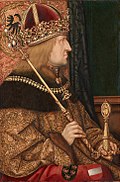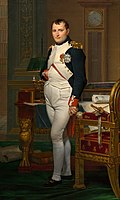| Image | Coat of arms | Name | King | Emperor | Ended | Notes |
|---|
 Non-contemporary Non-contemporary |  | Albert II
(Albrecht II.) | 17 March 1438 [16] | — | 27 October 1439 | 4th in descent from Albert I;
son-in-law of Sigismund |
 |  | Frederick III
(Friedrich III.) | 2 February 1440 | 16 March 1452 | 19 August 1493 | 4th in descent from Albert I; 2nd cousin of Albert II |
 |  | Maximilian I
(Maximilian I.) | 16 February 1486 | 4 February 1508 | 12 January 1519 | Son of Frederick III; King of Germany under his father, 1486–1493; assumed the title "Elected Emperor" in 1508 with the pope's approval |
 |  | Charles V
(Karl V.) | 28 June 1519 | 28 June 1519 | 3 August 1556 | Grandson of Maximilian I; died 21 September 1558. Last Emperor to receive the imperial coronation from the Pope. |
 |  | Ferdinand I
(Ferdinand I.) | 5 January 1531 | 27 August 1556 | 25 July 1564 | Grandson of Maximilian I; brother of Charles V; King of Germany under his brother Charles V 1531–1556; last king to be crowned in Aachen Cathedral. Emperor |
 |  | Maximilian II
(Maximilian II.) | 22 November 1562 | 25 July 1564 | 12 October 1576 | Son of Ferdinand I;
King of Germany under his father 1562–1564 |
 |  | Rudolf II
(Rudolf II.) | 27 October 1575 | 12 October 1576 | 20 January 1612 | Son of Maximilian II;
King of Germany under his father, 1575–1576 |
 |  | Matthias
(Matthias) | 13 June 1612 | 13 June 1612 | 20 March 1619 | Son of Maximilian II |
 |  | Ferdinand II
(Ferdinand II.) | 28 August 1619 | 28 August 1619 | 15 February 1637 | Grandson of Ferdinand I |
 |  | Ferdinand III
(Ferdinand III.) | 22 December 1636 | 15 February 1637 | 2 April 1657 | Son of Ferdinand II;
King of Germany under his father 1636–1637 |
 |  | Ferdinand IV
(Ferdinand IV.) | 31 May 1653 | — | 9 July 1654 | Son of Ferdinand III;
King of Germany under his father |
 |  | Leopold I
(Leopold I.) | 18 July 1658 | 18 July 1658 | 5 May 1705 | Son of Ferdinand III |
 |  | Joseph I
(Josef I.) | 23 January 1690 | 5 May 1705 | 17 April 1711 | Son of Leopold I; King of Germany under his father 1690–1705 |
 |  | Charles VI
(Karl VI.) | 12 October 1711 | 12 October 1711 | 20 October 1740 | Son of Leopold I |
|
|---|
 |  | Charles VII
(Karl VII.) | 24 January 1742 | 24 January 1742 | 20 January 1745 | Member of the House of Wittelsbach . Great-great-grandson of Ferdinand II; Husband of Maria Amalia, daughter of Joseph I |
|
|---|
 |  | Francis I
(Franz I.) | 13 September 1745 | 13 September 1745 | 18 August 1765 | Husband of Maria Theresa I |
 |  | Joseph II
(Joseph II.) | 27 March 1764 | 18 August 1765 | 20 February 1790 | Son of Maria Theresa I and Francis I; King of Germany under his mother and father 1764–1765 |
 |  | Leopold II
(Leopold II.) | 30 September 1790 | 30 September 1790 | 1 March 1792 | Son of Maria Theresa I and Francis I |
 |  | Francis II
(Franz II.) | 5 July 1792 | 5 July 1792 | 6 August 1806 | Son of Leopold II; Dissolved the Holy Roman Empire; also Emperor of Austria 1804–1835; President of the German Confederation (1815-1835), died 1835 |














































































































